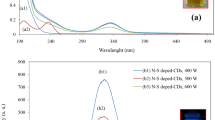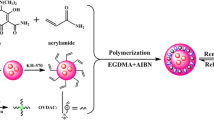Abstract
The efficient preparation of ratiometric fluorescent molecularly imprinted polymer (MIP) microspheres that can directly and selectively optosense a herbicide (i.e., 2,4-dichlorophenoxyacetic acid, 2,4-D) in undiluted pure milk is described. The dual fluorescent MIP microparticles were readily obtained through grafting a green 4-nitrobenzo[c][1,2,5]oxadiazole (NBD)-labeled 2,4-D-MIP layer with hydrophilic polymer brushes onto the preformed uniform “living” red CdTe quantum dot (QD)-labeled SiO2 microspheres via one-pot surface-initiated atom transfer radical polymerization (SI-ATRP) in the presence of a polyethylene glycol macro-ATRP initiator. They proved to be highly promising “turn-on”-type fluorescent chemosensors with red CdTe QD (the maximum emission wavelength λe,max around 710 nm) and green NBD (λe,max around 515 nm) as the reference fluorophore and “turn-on”-type responsive fluorophore, respectively. The sensors showed excellent photostability and reusability, high 2,4-D selectivity and sensitivity (the limit of detection = 0.12 μM), and direct visual detection ability (a fluorescent color change occurs from red to blue-green with the concentration of 2,4-D increasing from 0 to 100 μM) in pure bovine milk. The sensors were used for 2,4-D detection with high recoveries (96.0–104.0%) and accuracy (RSD ≤ 4.0%) in pure goat milk at three spiking levels of both 2,4-D and its mixtures with several analogues. This new strategy lays the foundation for efficiently developing diverse complex biological sample-compatible ratiometric fluorescent MIPs highly useful for real-world bioanalyses and diagnostics.
Graphical Abstract







Similar content being viewed by others
References
Zhang H, Ye L, Mosbach K (2006) Non-covalent molecular imprinting with emphasis on its application in separation and drug development. J Mol Recognit 19:248–259
Hoshino Y, Shea KJ (2011) The evolution of plastic antibodies. J Mater Chem 21:3517–3521
Takeuchi T, Sunayama H (2018) Beyond natural antibodies-a new generation of synthetic antibodies created by post-imprinting modification of molecularly imprinted polymers. Chem Commun 54:6243–6251
Zhang H (2020) Molecularly imprinted nanoparticles for biomedical applications. Adv Mater 32:1806328
Xu S, Wang L, Liu Z (2020) Molecularly imprinted polymer nanoparticles: an emerging versatile platform for cancer therapy. Angew Chem Int Ed 60:3858–3869
Tse Sum Bui B, Auroy T, Haupt K (2022) Fighting antibiotic-resistant bacteria: promising strategies orchestrated by molecularly imprinted polymers. Angew Chem Int Ed 61:e202106493
Basabe-Desmonts L, Reinhoudt DN, Crego-Calama M (2007) Design of fluorescent materials for chemical sensing. Chem Soc Rev 36:993–1017
Haupt K, Mosbach K (2000) Molecularly imprinted polymers and their use in biomimetic sensors. Chem Rev 100:2495–2504
Canfarotta F, Whitcombe MJ, Piletsky SA (2013) Polymeric nanoparticles for optical sensing. Biotechnol Adv 31:1585–1599
Wackerlig J, Lieberzeit PA (2015) Molecularly imprinted polymer nanoparticles in chemical sensing-synthesis, characterisation and application. Sensor Actuat B-Chem 207:144–157
Wan W, Wagner S, Rurack K (2016) Fluorescent monomers: “bricks” that make a molecularly imprinted polymer “bright.” Anal Bioanal Chem 408:1753–1771
Yang Q, Li J, Wang X, Peng H, Xiong H, Chen L (2018) Strategies of molecular imprinting-based fluorescence sensors for chemical and biological analysis. Biosens Bioelectron 112:54–71
Zhang H (2021) Water-compatible fluorescent molecularly imprinted polymers. In: Martín-Esteban A (ed) Methods in molecular biology 2359: Molecularly Imprinted Polymers-Methods and Protocols. Humana Press (Springer Nature), New York, pp 97–108
Wang X, Yu J, Wu X, Fu J, Kang Q, Shen D, Li J, Chen L (2016) A molecular imprinting-based turn-on ratiometric fluorescence sensor for highly selective and sensitive detection of 2,4-dichlorophenoxyacetic acid (2,4-D). Biosens Bioelectron 81:438–444
Lu H, Xu S (2017) Visualizing BPA by molecularly imprinted ratiometric fluorescence sensor based on dual emission nanoparticles. Biosens Bioelectron 92:147–153
Lian Z, Zhao M, Wang J, Yu RC (2021) Dual-emission ratiometric sensor based molecularly imprinted nanoparticles for visual detection of okadaic acid in seawater and sediment. Sensor Actuat B-Chem 346:130465
Sun X, Jiang M, Chen L, Niu N (2021) Construction of ratiometric fluorescence MIPs probe for selective detection of tetracycline based on passion fruit peel-carbon dots and europium. Microchim Acta 188:297
Hu X, Guo Y, Zhang J, Wang X, Fang G, Wang S (2022) A signal-amplified ratiometric fluorescence biomimetic sensor based on the synergistic effect of IFE and AE for the visual smart monitoring of oxytetracycline. Chem Eng J 433:134499
Li W, Zhang H, Chen S, Liu Y, Zhuang J, Lei B (2016) Synthesis of molecularly imprinted carbon dot grafted YVO4:Eu3+ for the ratiometric fluorescent determination of paranitrophenol. Biosens Bioelectron 86:706–713
Yang Q, Li C, Li J, Wang X, Arabi M, Peng H, Xiong H, Chen L (2020) Rational construction of a triple emission molecular imprinting sensor for accurate naked-eye detection of folic acid. Nanoscale 12:6529–6536
Hou Y, Zou Y, Zhou Y, Zhang H (2020) Biological sample-compatible ratiometric fluorescent molecularly imprinted polymer microspheres by RAFT coupling chemistry. Langmuir 36:12403–12413
Xu S, Zou Y, Zhang H (2020) Well-defined hydrophilic “turn-on”-type ratiometric fluorescent molecularly imprinted polymer microspheres for direct and highly selective herbicide optosensing in the undiluted pure milks. Talanta 211:120711
Zhang H (2013) Controlled/“living” radical precipitation polymerization: a versatile polymerization technique for advanced functional polymers. Eur Polym J 49:579–600
Zhao M, Chen X, Zhang HT, Yan H, Zhang H (2014) Well-defined hydrophilic molecularly imprinted polymer microspheres for efficient molecular recognition in real biological samples by facile RAFT coupling chemistry. Biomacromolecules 15:1663–1675
Ton XA, Tse Sum Bui B, Resmini M, Bonomi P, Dika I, Soppera O, Haupt K (2013) Versatile fiber-optic fluorescence sensor based on molecularly imprinted microstructures polymerized in situ. Angew Chem Int Ed 52:8317–8321
Yang Y, Niu H, Zhang H (2016) Direct and highly selective drug optosensing in real, undiluted biological samples with quantum-dot-labeled hydrophilic molecularly imprinted polymer microparticles. ACS Appl Mater Interfaces 8:15741–15749
Fischer H (1997) The persistent radical effect in “living” radical polymerization. Macromolecules 30:5666–5672
Zhang H, Klumperman B, Ming W, Fischer H, van der Linde R (2001) Effect of Cu(II) on the kinetics of the homogeneous atom transfer radical polymerization of methyl methacrylate. Macromolecules 34:6169–6173
Ma Y, Pan G, Zhang Y, Guo X, Zhang H (2013) Narrowly dispersed hydrophilic molecularly imprinted polymer nanoparticles for efficient molecular recognition in real aqueous samples including river water, milk, and bovine serum. Angew Chem Int Ed 52:1511–1514
Boonpangrak S, Whitcombe MJ, Prachayasittikul V, Mosbach K, Ye L (2006) Preparation of molecularly imprinted polymers using nitroxide-mediated living radical polymerization. Biosens Bioelectron 22:349–354
Zhang H (2014) Water-compatible molecularly imprinted polymers: promising synthetic substitutes for biological receptors. Polymer 55:699–714
Apodaca DC, Pernites RB, Ponnapati RR, Del Mundo FR, Advincula RC (2011) Electro polymerized molecularly imprinted polymer films of a bis-terthiophene dendron: folic acid quartz crystal microbalance sensing. ACS Appl Mater Interfaces 3:191–203
Hamilton D, Ambrus A, Dieterle R, Felsot A, Harris C, Holland P, Katayama A, Kurihara N, Linders J, Unsworth J, Wong S (2003) Regulatory limits for pesticide residues in water (IUPAC technical report). Pure Appl Chem 75:1123–1155
Han DM, Jia WP, Liang HD (2010) Selective removal of 2,4-dichlorophenoxyacetic acid from water by molecularly-imprinted amino-functionalized silica gel sorbent. J Environ Sci 22:237–241
Jakubowski W, Min K, Matyjaszewski K (2006) Activators regenerated by electron transfer for atom transfer radical polymerization of styrene. Macromolecules 39:39–45
Funding
This work was financially supported by the National Natural Science Foundation of China (21574070 and 22071121) and the Project supported by the NCC Fund (NCC2020PY12).
Author information
Authors and Affiliations
Corresponding author
Ethics declarations
Conflict of interest
The authors declare no competing interests.
Additional information
Publisher's note
Springer Nature remains neutral with regard to jurisdictional claims in published maps and institutional affiliations.
Supplementary Information
Below is the link to the electronic supplementary material.
Rights and permissions
Springer Nature or its licensor (e.g. a society or other partner) holds exclusive rights to this article under a publishing agreement with the author(s) or other rightsholder(s); author self-archiving of the accepted manuscript version of this article is solely governed by the terms of such publishing agreement and applicable law.
About this article
Cite this article
Li, Q., Zhang, W., Liu, X. et al. Preparation of complex biological sample-compatible “turn-on”-type ratiometric fluorescent molecularly imprinted polymer microspheres via one-pot surface-initiated ATRP. Microchim Acta 189, 464 (2022). https://doi.org/10.1007/s00604-022-05551-8
Received:
Accepted:
Published:
DOI: https://doi.org/10.1007/s00604-022-05551-8




